
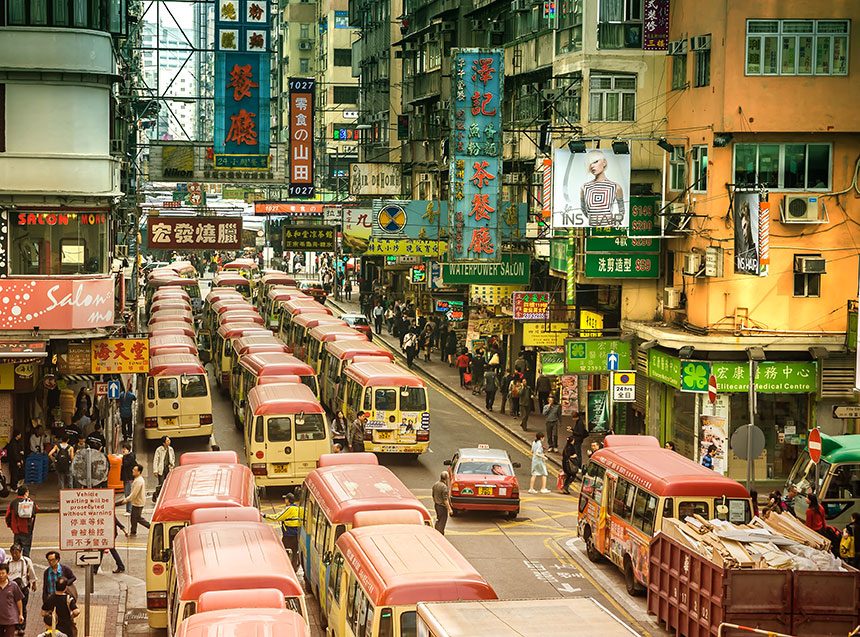 Image credit: huad262
Image credit: huad262If you’re planning your trip to Hong Kong anytime soon, it’s best to learn about transportation options that exist there before you actually land at the airport.
Hong Kong’s highly developed public transport network makes it a tourist-friendly destination for visitors. Means of transport are abundant for us to choose from: Metro, buses, minibuses, trams, ferries and so on.
In fact, Hong Kong has the world’s highest rate of daily journeys made on public transport (more than 90%!).
And that doesn’t come as a surprise since public transport in Hong Kong is affordable, fast and very efficient.
Let’s figure out which modes of transportation in Hong Kong are best suited for your needs and budget.
See also: Best Ways to Get from Hong Kong International Airport to City
Tourist Day Ticket
If you know you’ll be travelling a lot around Hong Kong on the day of your arrival (or some other days), consider buying Tourist Day Tickets, which gives you unlimited free access to main MTR (Mass Transit Railway) and certain Light Rail lines.
You can purchase a Tourist Day Ticket at the price of HK$65 ($8.5) and enjoy free rides for 24 hours.
The Tourist Day Ticket is valid for 1 month since the day you bought it. This kind of ticket is available only to non-residents of Hong Kong who will be staying there for less than 2 weeks.
Octopus Card
For those staying in Hong Kong for more than a couple of days, the Octopus Card will help a lot. It is a rechargeable card that can be used on pretty much all modes of public transportation in Hong Kong. And interestingly, it is accepted at convenience stores, fast food stalls and supermarkets.
You can purchase the Octopus Card for HK$150 ($20), including HK$100 of credit and HK$50 of refundable deposit. Children and seniors can buy the card for HK$70 ($9).
You’re spending about 4% – 8% less on fares with the Octopus Cards (compared to regular fares on the MTR). The cards can be purchased and reloaded at any MTR station.
Hong Kong eTransport App
We also recommend you to get the Hong Kong eTransport mobile app, which helps you to find the cheapest and fastest public transport routes to get to your destination.
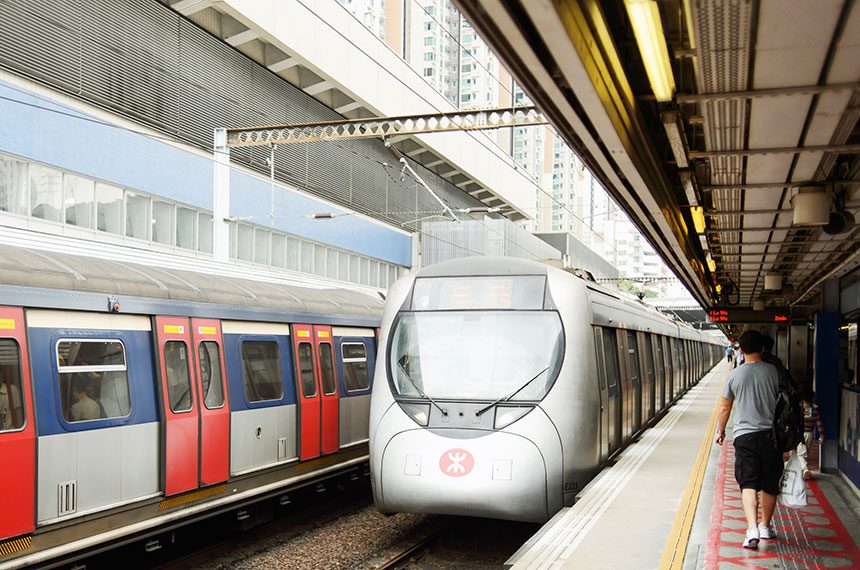 Image credit: TEA
Image credit: TEAHong Kong’s MTR is a fast and easy way to get to almost any places in Hong Kong. In fact, it’s one of the most advanced metro systems in the world.
Hong Kong’s sophisticated MTR system operates 9 subway lines throughout the entire city.
Traveling by metro may not be as cheap as bus travel, but it’s definitely faster and more comfortable than buses.
MTR hours: 06:00 – 01:00 daily (vary from line to line)
MTR schedule: Every 3 minutes (may be up to 20 minutes in the early morning and late night)
MTR fares: Range from HK$4.5 ($0.58) to HK$59.5 ($7.67) for a single journey, depending on the count of stops and the MTR line
Notes
– Check the MTR map here
– It’s always cheaper to use buses or ferries for short trips.
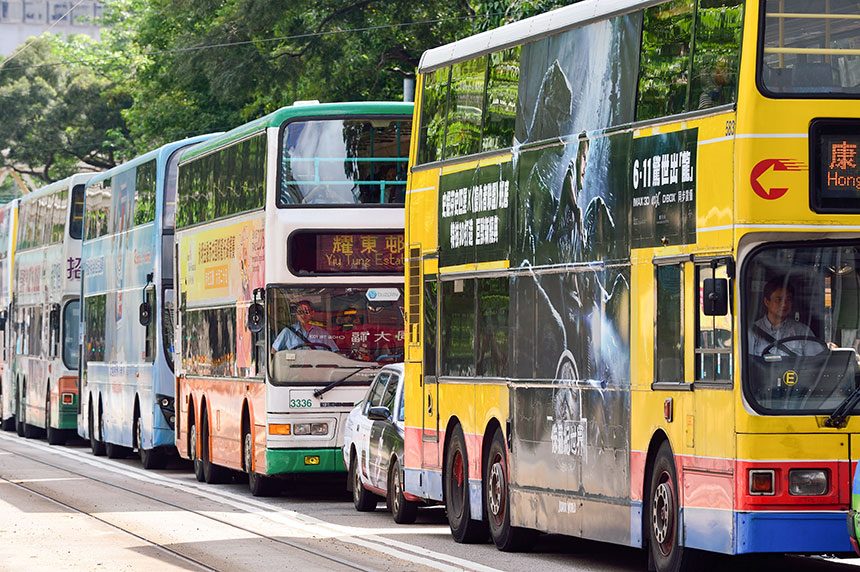 Image credit: TEA
Image credit: TEABuses and minibuses can take you pretty much anywhere in Hong Kong. It’s a great way to explore the city, especially the south side of Hong Kong Island and the New Territories.
Most buses in Hong Kong are double-decker and equipped with air conditioning. It’s a pretty affordable mode to get around in Hong Kong, but may not be the most pleasant one during rush hours as it gets very crowded in buses.
Pay special attention to information boards at bus stops because they display detailed info about routes as well as ticket fares.
Hong Kong buses are self-service, meaning you’ll never be given change. So make sure you always carry around lots of HK$1s and HK$2s (if you pay the fares in cash).
In order to get off the bus, you must press an electronic button near the exit at least 5 second before the bus approaches your bus stop.
Central Bus Terminus: In central Hong Kong, on the ground floor of the Exchange Square, there is a large bus terminus, where you can take special route buses to places that cannot be reached by MTR. Those places include Repulse Bay, Stanley, Aberdeen, andVictoria Peak (take bus #15).
Bus hours: 24 hours for major routes
Bus schedule: Every 10 to 15 minutes
Bus fares: From HK$4.3 ($0.55) to HK$39.4 ($5.08) depending on the routes and the travel distance
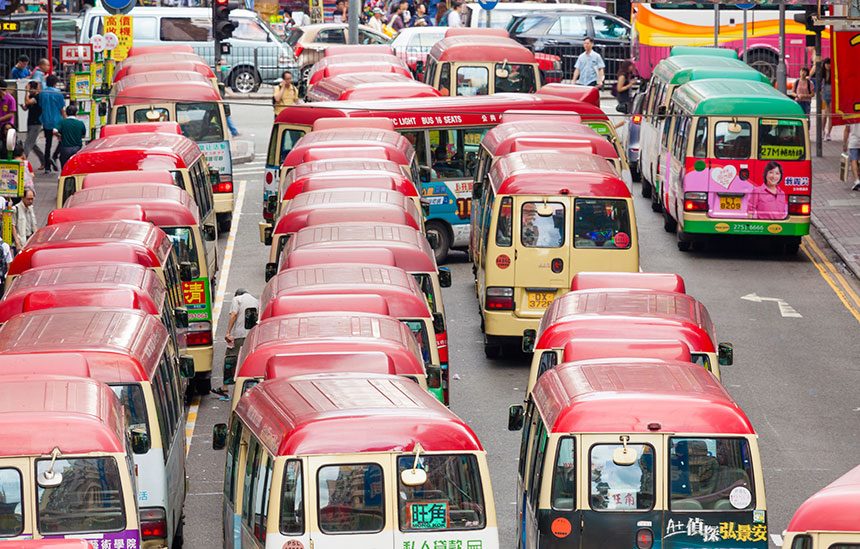 Image credit: ymgerman
Image credit: ymgermanMinibuses, which are also called public light buses, are widely used by locals. A minibus can carry maximum 16 people.
There are two types of minibuses: red and green.
Red minibuses can pick up passengers wherever they are hailed and stop at a passenger’s request. This is the only type of bus in Hong Kong that the driver gives you change. Octopus card can be used on certain routes.
Green minibuses make designated stops so it won’t stop just anywhere you ask along the fixed route (like red minibuses do). No change is given in green minibuses as you have to put cash in the box or use the Octopus card.
Minibuses are a fun way to get around in Hong Kong, but it’s more preferred if you know at least some Chinese, because some minibuses have all the info (about fares and routes) in Chinese and drivers don’t speak English.
Minibus hours: 24 hours for major routes
Minibus schedule: Every 10 to 15 minutes
Minibus fares: From HK$7 ($0.9) to HK$40 ($5.2) for red minibuses; HK$3 ($0.4) to HK$24 ($3) for green minibuses
Note: If a minibus is full, it won’t stop to pick up new passengers.
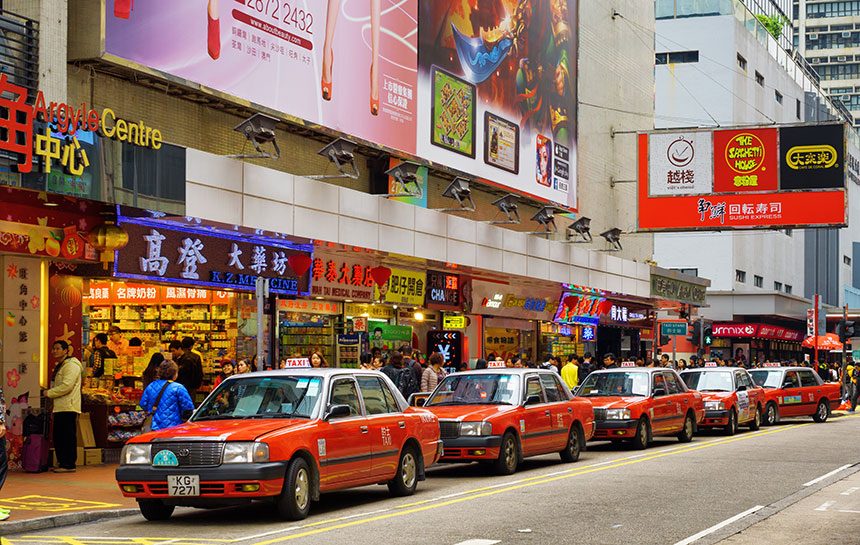 Image credit: efired
Image credit: efiredCompared with other big modern cities in the world, Hong Kong’s taxi services are not too expensive. However, it’s still not the cheap way to get around in Hong Kong.
It’s also not the best option during rush hours, because Hong Kong roads tend to get crowded during these hours. Also, you can’t catch a taxi at bus stops and other restricted areas (where the curb is painted yellow).
As for the cost, let’s do some math. If you need to go from central Hong Kong to Manly Plaza, the city’s major shopping area, you’d spend about HK$90 ($11.6) for taxi fee.
If you use a tram, you’d spend only HK$2.3 ($0.3). HK$4.1 ($0.5) is the cost if you take a bus. You see, knowing which modes of transportation are more cost-efficient helps save your budget.
A good part of Hong Kong taxi services is that most of their taxis have a card that lists the city’s top 50 destinations in English, Japanese and Chinese.
And since most Hong Kong taxi drivers don’t speak English, you should have your destination written down on a piece of paper in Chinese (if you can ‘draw’ or have a Chinese friend).
Taxi hours: 24 hours
Taxi fares
– Red taxis: HK$22 ($2.84) for first 2 km; HK$1.6 ($0.2) per every subsequent 200 meters
– Green taxis: HK$18.5 ($2.4) for first 2 km; HK$1.4 ($0.18) per every subsequent 200 meters
– Blue taxis: HK$17 ($2.2) for first 2 km; HK$1.4 ($0.18) per every subsequent 200 meters
Notes
– You’ll be charged HK$5 ($0.6) for each piece of luggage (except light personal handbags).
– If the taxi goes through any harbor tunnel that charges a toll, you’ll have to pay the taxi driver the toll x 2, to cover the fee for him to return to his starting place.
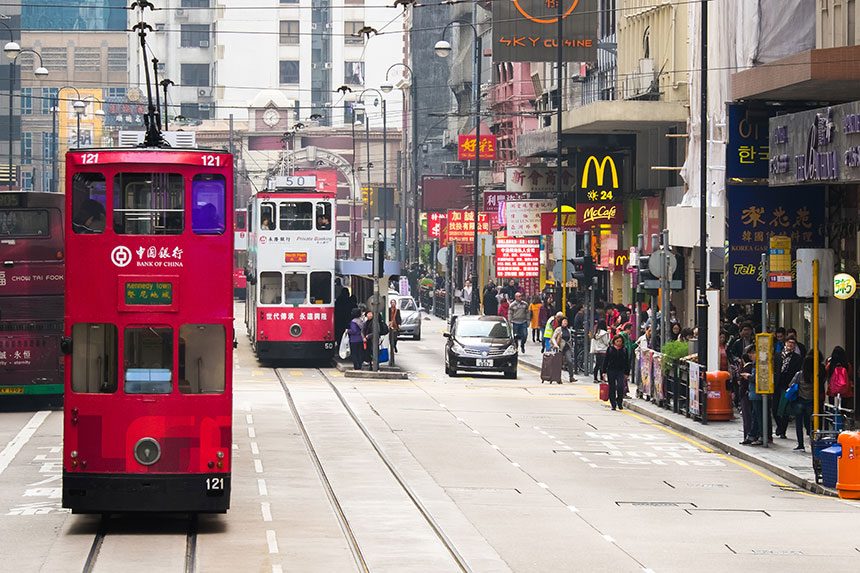 Image credit: lakhesis
Image credit: lakhesisHong Kong’s double-decker trams have been serving the city since 1904, so you get to feel those nostalgic early 20-century vibes floating around.
Using a tram is not only a fun way to go sightseeing in Hong Kong, but also the cheapest way to reach popular destinations along the southern part of Hong Kong Island.
In order to take beautiful snaps using your smartphone or camera, take a seat next to a window on the upper deck.
You must hop on a tram on the rear side, and then exit the tram on the front side. Pay in cash (no change will be given) or via Octopus card when you exit the tram.
Tram routes: There are 6 tram routes, but they are actually 6 sub-divided routes of only one main route, which travels across Hong Kong island – from the western part (Kennedy Town terminus) to the eastern part (Shau Kei Wan terminus) and vice versa.
On your journey in a tram, you’ll be passing through Central, Admiralty, Wan Chai, Happy Valley, Causeway Bay as well as Tin Hau stations.
It takes the tram about 80 minutes to make the full journey from Kennedy Town to Shau Kei Wan.
Tram hours: around 05:30 – 00:30 daily
Tram schedule: Every 4 minutes during off-rush hours; every 1.5 minutes during rush hours
Tram fares: HK$2.3 ($0.3) for a single journey. Four-Day tram pass (unlimited rides) is available at HK34 ($4.38).
Note: Before you start your journey, check this interactive map, which shows where the tram can take you to.
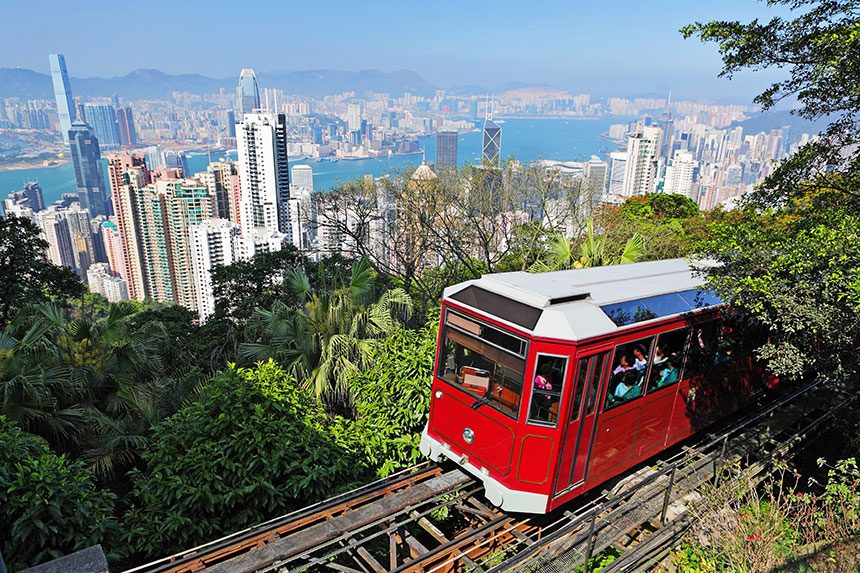 Image credit: leungchopan
Image credit: leungchopanIf you’re going to visit Hong Kong, you probably have ‘Visit Victoria Peak‘ in your bucket list.
The most practical way to reach the place is to take the Peak Tram, which will show you the mesmerizing and unforgettable views of Hong Kong.
The Peak Tram runs on the tracks following the slope of the mountain with its highest peak at 1,300 feet (396 meters). One Peak Tram is capable of carrying 120 passengers at a time.
To use the Peak Tram service, go to the Peak Tram Lower Terminus on Garden Road in Central Hong Kong.
Peak Tram hours: 07:00 – 00:00 daily
Peak Tram schedule: Every 10 to 15 minutes
Peak Tram fares: HK$32 ($4.1) for one-way trip; HK$45 ($5.8) for round trip
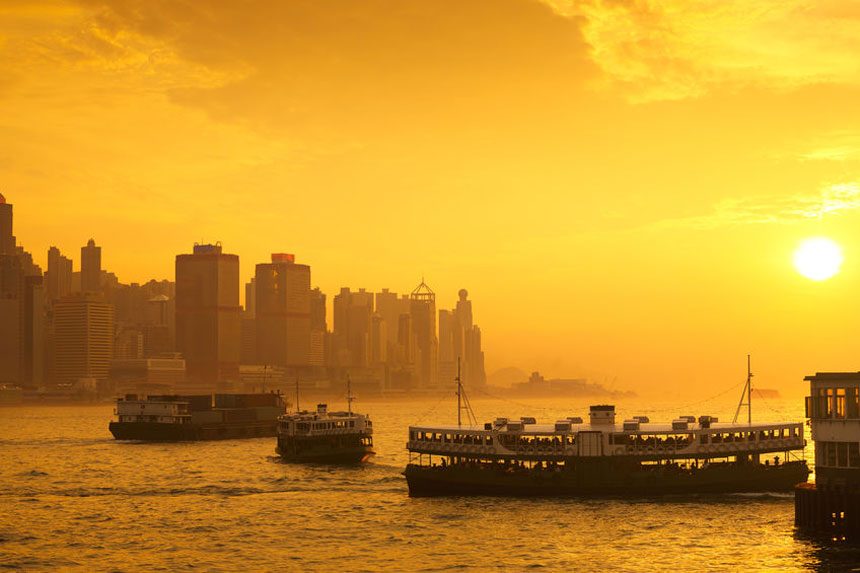 Image credit: pat138241
Image credit: pat138241Riding a ferry in Hong Kong is not only a cheap way to reach your destination, but also a great way to see the incredible scenery between Hong Kong Island and Kowloon.
In fact, Star Ferry’s main route from Central to Tsim Sha Tsui was rated first in the Top 10 Most Exciting Ferry Rides poll.
Ferries that depart from the Central ferry piers offer you trips to main Outlying Islands of Peng Chau, Cheung Chau, Lamma Island and Lantau Island, including Discovery Bay.
There are two kinds of ferries you can find in Hong Kong: regular ferries and fast ferries.
The Central ferry pier is about 5 minutes walking distance from the Hong Kong MTR station.
Star Ferry service hours: 06:30 – 23:30 daily
Star Ferry service schedule: Every 6 to 12 minutes
Star Ferry fares
– Mon to Fri: HK$2 ($0.26) for lower deck and HK$2.5 ($0.32) for upper deck
– Sat, Sun, and holidays: HK$2.8 ($0.36) lower deck and HK$3.4 ($0.44) upper deck
– Free rides for children under 3
Note: Apart from Star Ferry, there are also 3 other ferry service providers: New World First Ferry, Discovery Bay Transportation Services, and Hong Kong and Kowloon Ferry.
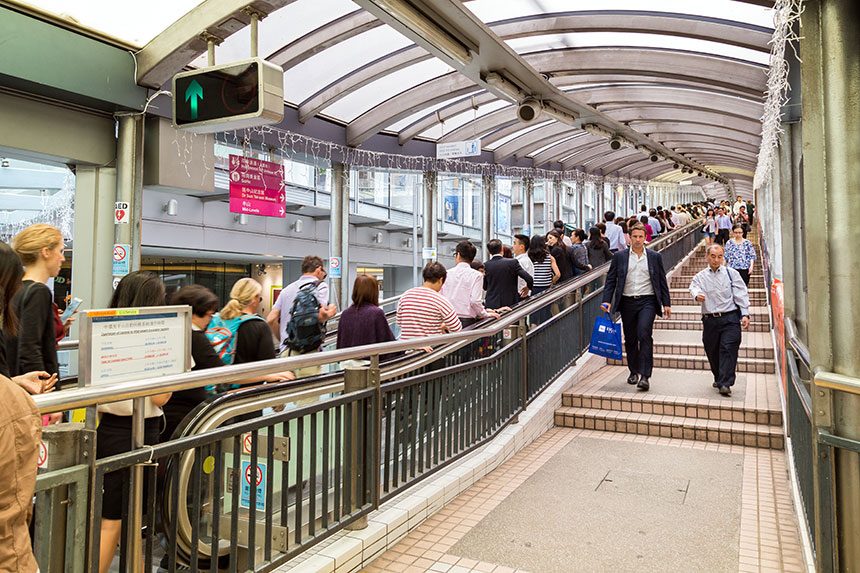 Image credit: tuomaslehtinen
Image credit: tuomaslehtinenCentral–Mid-Levels Escalator provides a free and fun way to travel from Central Hong Kong to Mid-Levels, which is an affluent residential area in the city.
This escalator system, which serves over 85,000 people every day, is the longest outdoor covered escalator system in the world. It has also been featured in CNN’s list of the Coolest Commutes in the World in 2015.
The whole system is 800 meters long, consisting of 20 escalators and 3 inclined travelators, passing many crowded areas including Central Market, Hollywood Road and Shelley Street. It takes you about 20 minutes to complete the full trip.
The escalators and travelators operate only one-way at a time, they run downhill from 06:00 – 10:00 then uphill 10:00 – 00:00, every day.
You can get off at Soho (entertainment zone) and enjoy Hong Kong’s famous delicacies. From there, you can easily walk to Lan Kwai Fong, which has an abundance of night clubs and bars.
The starting point of escalator system is at 100 Queens Road Central at its junction with Cochrane Street, which is 6 minutes walking distance from the Central MTR Station (Exit D2). You can also reach there by tram – get off at Hang Seng Bank HQ station and walk for 2 minutes.